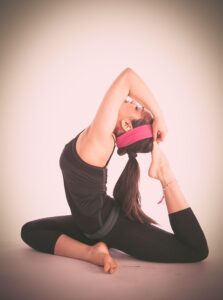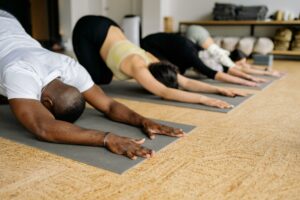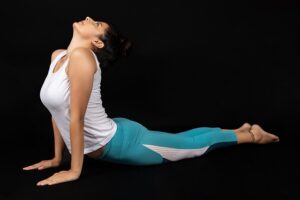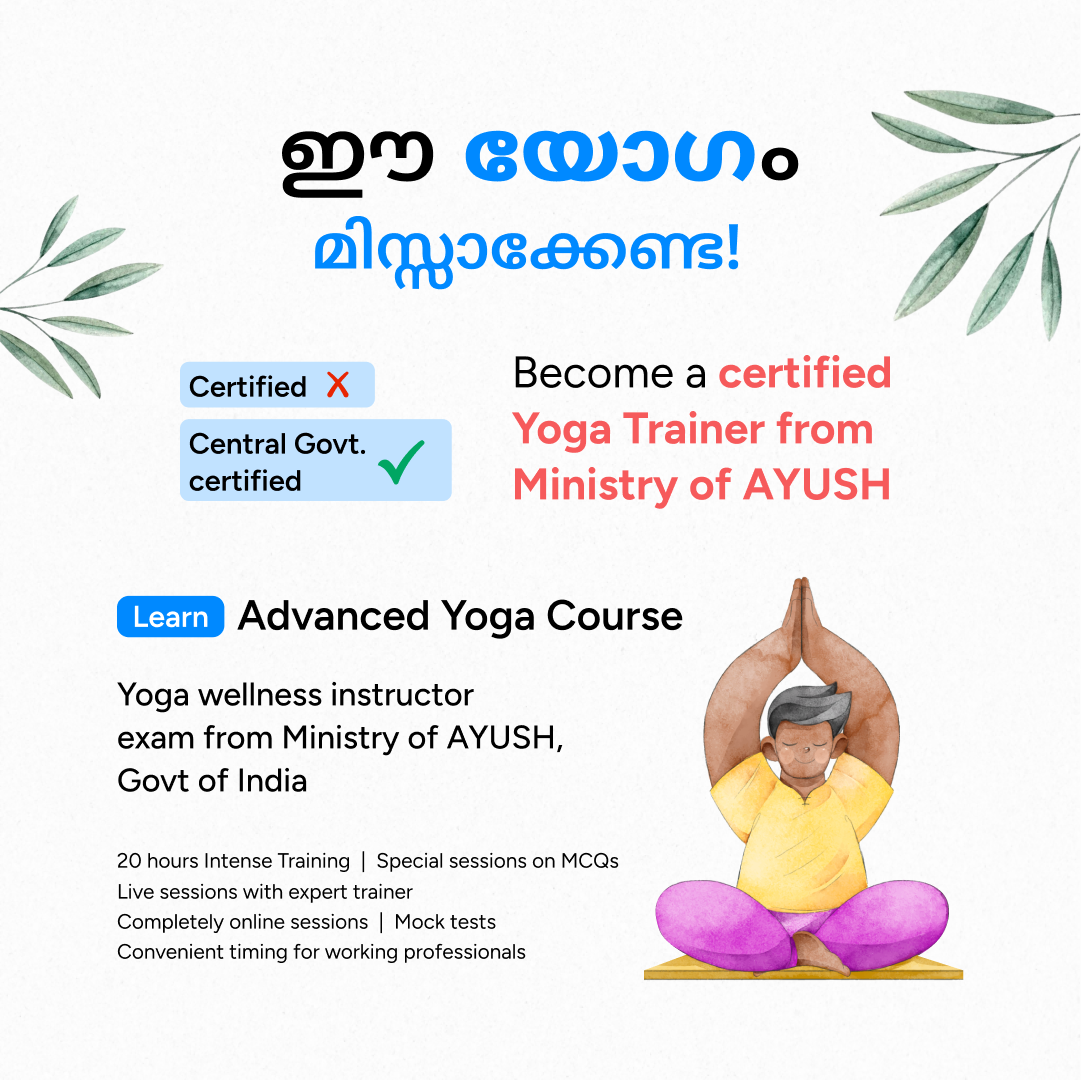Table of Contents
As a yoga teacher working with athletes, you just add a secret sauce – Yoga – which unifies and increases their work by helping them feel connected, balanced and present at the moment.
Getting a clear image of support teams that athletes have around you will help you see your role more clearly. And as soon as you see this role clearly, you will feel more sure that you can do it. You will know that yoga teaching does not mean that you have to offer fitness, rehabilitation, sports psychology, nutritional counseling, legal services or anything, except in the scope of our practice as yoga teachers.
Master the art of Yoga from Entri, Enroll now!
Key Yoga Practices for Athletes
Downward Facing Dog: Start on your hands and knees, with your arms width apart and knee width hip. Lift the hips up and forth and straighten your hands and feet as much as possible. Keep your head and neck relaxed and hold a few breaths.
1. Warrior II:
Start in a mountain pose, with your feet a point apart. Enter the left foot back and turn it at an angle of 90 degrees. Bend the right knee, keep it over the ankle and stretch your hands on the sides. Hold a few breaths and then switch the sides.
2. Tree Pose:
Stand with your feet, hip width apart and move your weight to your left leg. Bring the right leg to rest on the left thigh and press your hands in front of the heart. Hold a few breaths and then switch the sides.
3. Crescent Lunge:
Start in a mountain pose and then put your left leg back into the lunge position. Raise your hands over your head and keep your shoulders relaxed. Hold a few breaths and then switch the sides.
4. Plank Pose:
Start on your hands and knees, then straighten your legs behind and keep your body in a straight line. Hold a few breaths and engage your basic muscles to keep your body stable.
5. Pigeon Pose:
Start with the dog downwards, then bring the right knee forward and place it between your hands. Stretch your left leg behind you and run on the forearm. Hold a few breaths and then switch the sides.
6. Bridge Pose:
Lie on your back with bent knees and feet. Raise the hips up, push your legs into the floor and plug in glutes and hamstrings. Hold a few breaths, then down.
7. Child’s Pose:
Start on your hands and knees and then run the hips back to the heel. Stretch your hands in front of you and place your forehead on the floor. Hold a few breaths and release any tension in your body.
8. Cobra Pose:
Lie on your stomach with your hands under your shoulders. Raise your chest up and keep your shoulders relaxed and elbows near your body. Hold a few breaths, then down.
9. Seated Forward Bend:
Sit on the floor with your feet right in front of you. Reach your hands up, then fold forward and stretch your fingers or ankles. Hold a few breaths and then release.
Master the art of Yoga from Entri, Enroll now!
How To Become a Yoga Coach for Athletes
1: Which of these is the primary goal of yoga practice?
To become a Yoga coach for athletes, you first achieve certification of yoga teachers (eg 200 hours or higher), then specialize in athletes’ yoga through advanced courses or workshops, and finally gain experience with class leaders or consultation with athletes and sports teams.
Here is a more detailed schedule:
1.Foundation: Become a Yoga teacher
- Yoga Teachers Training (TTC):
Complete yoga training course, ideally a 200 -hour certification of yoga teacher (engraving) or higher to create your basic knowledge and teaching skills.
- Yoga Alliance:
Consider that you will become a registered yoga teacher (engraving) through yoga alliance, a non -profit organization that sets standards for education of yoga teachers and professional development.
- Understand the basics:
Get a strong understanding of yoga philosophy, anatomy, physiology and teaching methodologies.
- Explore different styles:
While the general principles of yoga are important, explore different styles like vinyasa, yin or hatha to find your preferred access to teaching.
2.Specialization: Yoga for Athletes
- Advanced training:
Make specialized courses, workshops or certification focused on athletes, injury or rehabilitation.
- Anatomy and Physiology:
Improve your understanding of how yoga represents, affects the musculoskeletal system and focuses on the needs of athletes and injuries.
- Knowledge of athletics:
You will learn about different sports and their body requirements, allowing you to adapt your yoga practices appropriately.
- Edit and modifications:
Learn to adjust the poses to suit the level of athletes’ skills, restrictions and specific needs.
- Consult with experts:
Look for instructions from experienced yoga teachers who specialize in working with athletes or sports professionals.
3.Gain Experience
- Lead class:
Start by teaching Yoga classes, adapting to your teaching for athletes and their needs.
- Working with teams:
Offer private sitting or consult with sports teams to help athletes integrate yoga into their training and recovery routines.
- Develop the network:
Connect with other yoga teachers, coaches, therapists and athletes to expand your knowledge and opportunities.
- Create content:
Document your way and knowledge such as Yoga coach athlete, creating blog posts, articles or creating online courses.
- Build a portfolio:
Gather assessments from athletes and create a portfolio that will present your expertise and experience to gain credibility.
4.Further Development
- Continue learning:
Stay in accordance with the latest research and techniques of yoga for athletes through programs and conferences of further education.
- Specialized certification:
Consider obtaining advanced certificates such as certification offered by Yogafit or National Academy of Sports Medicine (NATM).
- Expand your expertise:
Consider the study of other topics related to athletics such as kinesiology or rehabilitation to infirm even more and more efficient.
Become a Certified Yoga Instructor
Yoga Teacher Training Course by Entri App: Master authentic yoga techniques, earn certification, and build a successful career as a professional yoga instructor.
Join Now!Marketing Yourself As a Yoga Coach for Athletes
Understanding Your Personal Teaching Style
Define what you do differently before you sell. Yoga students are attracted by instructors who can provide something else. Ask yourself:
- What kind of yoga did I experience? (Vinyasa, Yin, Hatha, etc.)
- Do I talk to beginners, experienced practices or certain groups such as athletes or older individuals?
- What is my personal style of teaching?
Understanding your niche you can build a brand that is authentic and attracts the relevant students. The most successful yoga teachers create distinctive styles that distinguish them on the market.
Developing a Strong Web Presence
In 2025 it is essential to have a strong online presence. A professional website can sell your experience, services and recommendations. Your online presence on Instagram, YouTube and Tiktok can be a great tool for building audiences.
To improve your online presence:
- Create a professional website that contains classroom plans, student opinions and blogs.
- Post interesting content such as yoga teaching, yoga tips and live courses.
- Use SEO methods to achieve a higher rating when searching for yoga.
- Interaction with followers via comments and messages back.
If you offer online courses, optimize your website for planning and payment. The more you are, the easier it is for students to have a meeting with you.
Development through Social Media
Social media is the best means of drawing students. On Instagram and YouTube, many yoga enthusiasts are looking for inspiration.
- Instagram: Share short yoga flows, position deconstruction and students’ feedback. Use reels and stories to promote engagement.
- YouTube: Create learning teaching programs, mentoring class and study guide.
- Facebook & Tiktok: Connect with Yoga Communities, Live Q&S hosts, and publish videos behind the scenes.
Consistency is crucial. Regular publication of posts with good content creates confidence and maintains your audience.
Networking and Collaborations
The design of your yoga career is not entirely web marketing. Networks with other medical practitioners can open new doors. Take part in events, join Retreats and a partner with local yoga centers. Techniques to build a good bond:
- A partner with wellness marks to address more individuals.
- Working with other instructors on the management of workshops or co -found retreats.
- Take part in yoga conventions and learn and network with professionals.
Recommendations about the oral word are still one of the most powerful marketing tools and good professional relationships will help you in the long run.
Why Continuous Learning Is Important
The yoga industry is constantly changing and continuing education gives you before the game. Effective instructors in most cases spend money for ongoing education to improve their abilities.
- Given the Yoga teacher training course will allow you to learn sophisticated methods.
- Learning new yoga styles can increase your teaching range.
- Participation in workshops and concessions increases your teaching skills.
Continued education not only adds to your profile, but also allows you to offer new and innovative programs that attract more students.
Offering Online and Classroom Courses
Offline and online education expands your audience. Some pupils want to learn in the classroom while others appreciate the comfort of online learning.
Advantages of online courses:
- Increased reach into the community outside the students.
- Flexible timetables for students and teachers.
- Sources of passive income through recorded sessions.
Personal classes benefits:
- Individualized support and involvement of students.
- Improved retaining students and building community.
- The opportunity to perform workshops and individual sessions.
Having both versions at the same time allows you to optimize your profit and influence.
Creating Passive Income Streams
Requiring only class fees can reduce your income. Through the diversification of your earnings with passive income you will be able to earn money, even if you do not use it.
Some ideas include:
- Marketing online products such as yoga books, guides or video courses.
- Start online courses that students can buy at any time.
- Monitoring YouTube through income from advertising for teaching and led sessions.
- Affiliate marketing by selling yoga products.
These measures can help you become economically stable and at the same time serve your passion for teaching.
Coping with Challenges as a New Yoga Teacher
Most novice teachers undergo doubts and gradual growth. Do they often ask-hard to train yoga teacher? That’s not. It only takes you to be patient and persistent. Normal problems are:
- Hiring students in an open market.
- Mixing marketing and education without flooding.
- Finance management at the beginning with several students.
Career development does not occur overnight, but with a positive approach and approach you can build a loyal student and become a respected teacher.
Conclusion
Accept today! Marketing is a job as an instructor of yoga, but the paycheck is worth it. From creating online presence to continuing education, every step along the way makes you a better instructor. If you are ready to transfer it to the next level, consider enrollment in the Entri Yoga Training Course to polish your skills and create more options. If you are a newcomer or are trying to move forward, it is time to act now. Start building your brand today and hire willing students to teach you!
Master the art of Yoga from Entri, Enroll now!
Become a Certified Yoga Instructor
Yoga Teacher Training Course by Entri App: Master authentic yoga techniques, earn certification, and build a successful career as a professional yoga instructor.
Join Now!Frequently Asked Questions
How to be a yoga teacher?
To get certified as a yoga teacher, take a certified course, gain practical experience, and have a good marketing strategy in place to get students.
Is yoga teaching training difficult?
Yoga teaching requires commitment, but with the right attitude and support, it is a valuable and rewarding experience.
How long does it take to establish a teaching career in yoga?
It is dependent, yet with dedication, marketing, and networking, one can build a steady career from 6 months to 2 years.

































